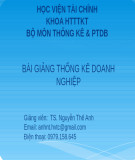Chapter 3
McGrawHill/Irwin
Copyright © 2014 by The McGrawHill Companies, Inc. All rights reserved.
Descriptive Statistics: Numerical Methods
Descriptive Statistics
3.1 Describing Central Tendency 3.2 Measures of Variation 3.3 Percentiles, Quartiles and Boxand
Whiskers Displays
3.4 Covariance, Correlation, and the Least
Square Line (Optional)
3.5 Weighted Means and Grouped Data
(Optional)
32
3.6 The Geometric Mean (Optional)
LO3-1: Compute and interpret the mean, median, and mode.
3.1 Describing Central Tendency
In addition to describing the shape of a distribution,
want to describe the data set’s central tendency ◦A measure of central tendency represents the center or
middle of the data
◦Population mean (μ) is average of the population
measurements
Population parameter: a number calculated from all the population measurements that describes some aspect of the population
Sample statistic: a number calculated using the
sample measurements that describes some aspect of the sample
33
LO3-1
Measures of Central Tendency
Mean, (cid:0) Median, Md
34
The average or expected value The value of the middle point of the ordered measurements The most frequent value Mode, Mo
LO3-2: Compute and interpret the range, variance, and standard deviation.
3.2 Measures of Variation
Knowing the measures of central tendency is
Both of the distributions below have identical measures of central tendency
35
Figure 3.13
not enough
LO3-2
Measures of Variation
Range
Largest minus the smallest measurement
Variance
The average of the squared deviations of all the population measurements from the population mean
The square root of the population variance
Standard Deviation
36
LO3-3: Use the Empirical Rule and Chebyshev’s Theorem to describe variation.
The Empirical Rule for Normal Populations
If a population has mean µ and standard deviation σ and is described by a normal curve, then
68.26% of the population measurements lie within one standard deviation of the mean: [µσ, µ+σ]
95.44% lie within two standard deviations of
99.73% lie within three standard deviations
the mean: [µ2σ, µ+2σ]
37
of the mean: [µ3σ, µ+3σ]
LO3-3
Chebyshev’s Theorem
Let µ and σ be a population’s mean and
At least 100(1 1/k2)% of the population measurements lie in the interval [µkσ, µ+kσ]
Only practical for nonmoundshaped distribution population that is not very skewed
38
standard deviation, then for any value k > 1
LO3-3
z Scores
For any x in a population or sample, the associated z
score is
(cid:0)
x
(cid:0)
z
mean deviation standard
The z score is the number of standard deviations
that x is from the mean ◦A positive z score is for x above (greater than) the mean ◦A negative z score is for x below (less than) the mean
39
LO3-4: Compute and interpret percentiles, quartiles, and box-and- whiskers displays.
3.3 Percentiles, Quartiles, and Boxand Whiskers Displays
For a set of measurements arranged in increasing order, the pth percentile is a value such that p percent of the measurements fall at or below the value and (100p) percent of the measurements fall at or above the value
The first quartile Q1 is the 25th percentile The second quartile (median) is the 50th percentile The third quartile Q3 is the 75th percentile The interquartile range IQR is Q3 Q1
310
LO3-5: Compute and interpret covariance, correlation, and the least squares line (Optional).
3.4 Covariance, Correlation, and the Least Squares Line (Optional)
When points on a scatter plot seem to
fluctuate around a straight line, there is a linear relationship between x and y A measure of the strength of a linear
n
relationship is the covariance sxy
yx
y
x i
i
(cid:0) (cid:0) (cid:0) (cid:0) (cid:0) (cid:0) (cid:0)
i
1
s
xy
(cid:0) (cid:0)
n
1
311
(cid:0)
LO3-6: Compute and interpret weighted means and the mean and standard deviation of grouped data (Optional).
3.5 Weighted Means and Grouped Data (Optional)
Sometimes, some measurements are more important
than others ◦Assign numerical “weights” to the data
Weights measure relative importance of the value
Calculate weighted mean as
(cid:0)
xw i i w i
where wi is the weight assigned to the ith measurement xi
312
(cid:0)
LO3-7: Compute and interpret the geometric mean (Optional).
3.6 The Geometric Mean (Optional)
For rates of return of an investment, use the geometric mean to give the correct wealth at the end of the investment
Suppose the rates of return (expressed as decimal fractions) are R1, R2, …, Rn for periods 1, 2, …, n
The mean of all these returns is the calculated as the geometric mean:
n
R
R
R
1
1
1
1
g
n
R 1
2
313
(cid:0) (cid:0) (cid:0) (cid:0) (cid:0) (cid:0) (cid:0) (cid:0) (cid:0) (cid:0) (cid:0) (cid:0) (cid:0) (cid:0)


























